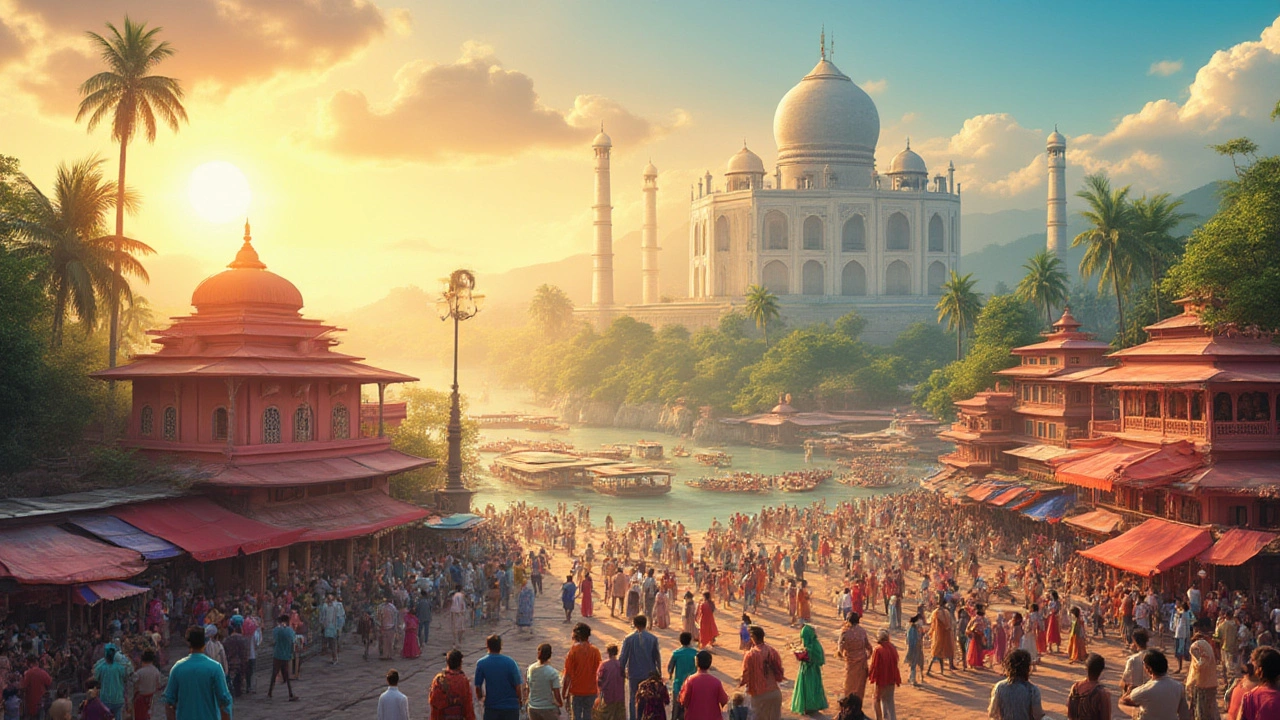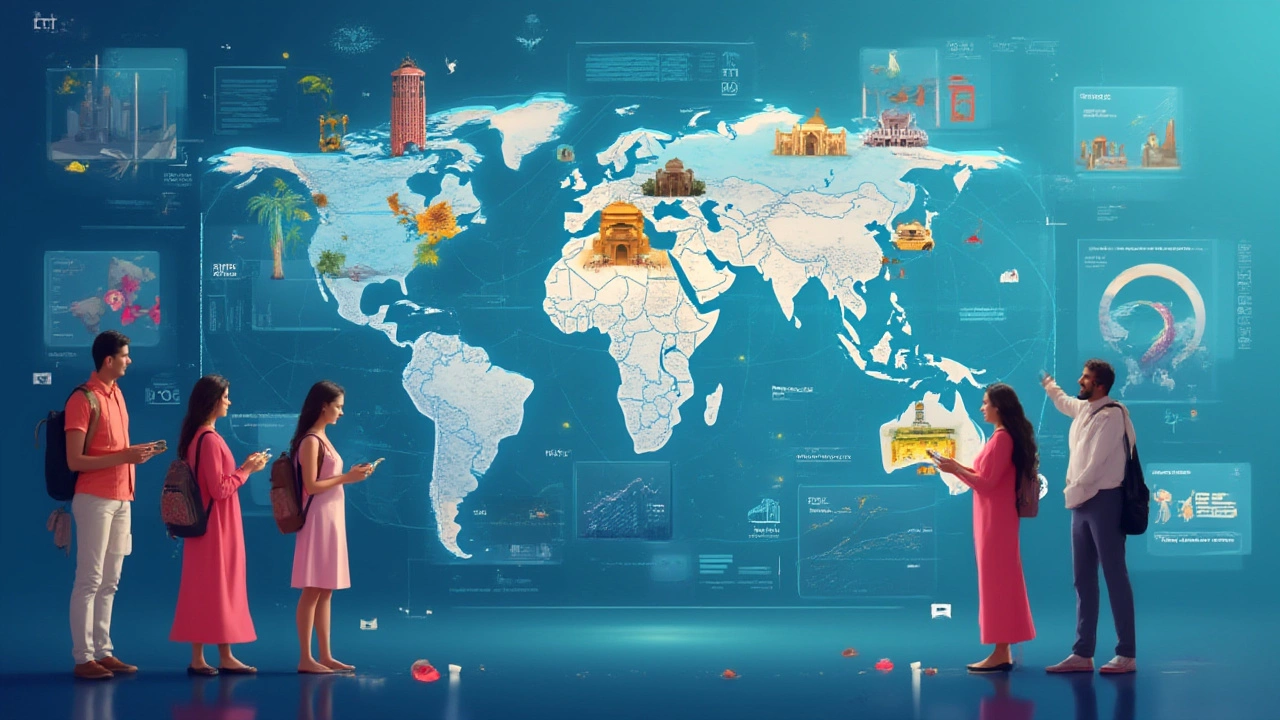India Tourism Ranking: Stats, Surprises, and Incredible Travel Insights

- Jul, 13 2025
- 0 Comments
- Aaron Blackwood
Feel like everyone you know has been to India or is dreaming about it? Turns out, India’s got a global reputation. For years, it’s been in the fast lane, attracting tourists with that unique cocktail of heritage, color, and adventure. But where does India actually rank compared to other powerhouses like France, Spain, or the US? And does the real experience match the numbers?
India on the World Tourism Map: Where Does the Country Stand?
Ask any hard-core traveler, and they’ll throw out words like "rich culture," "timeless temples," and "spicy food that blows your mind." Flip to the facts and you see the numbers: The United Nations World Tourism Organization’s (UNWTO) 2024 Tourism Highlights put India at 22nd spot for international tourist arrivals. That’s up several positions compared to a decade ago, when India languished outside the global top 30. Not exactly rubbing shoulders with France or Spain, which rake in over 75 million arrivals a year each, but you can’t ignore a country that welcomed around 16.8 million international tourists in 2023.
But hold on, the story changes when you check tourism receipts – basically, the money tourists spend. India’s ranking jumps up, breaking into the top 15 globally according to the UNWTO. Why? Visitors in India tend to stay longer and dig deeper into local experiences, from Himalayan treks to five-star palace hotels. So if you measure "impact" instead of just arrivals, India’s contribution to global travel culture is massive.
Here’s a snapshot of India’s position versus other key countries, looking at tourist arrivals and income from tourism:
| Country | International Tourist Arrivals (2023, million) | Tourism Receipts (Billion USD) |
|---|---|---|
| France | 89.4 | 68.5 |
| Spain | 83.5 | 65.1 |
| United States | 66.6 | 174.2 |
| Thailand | 33.1 | 45.7 |
| India | 16.8 | 29.2 |
| Turkey | 51.2 | 46.8 |
While India doesn't top either chart, that's a phenomenal growth story for a country that was barely noticed by the mainstream "bucket-list" crowd in the early 2000s. The best part? The diversity of travelers – from tight-budget backpackers in the Ganges to wedding guests at Jaipur palaces, and slow-travel yogis in Rishikesh.
What Makes India So Magnetic for Tourists?
It’s one thing to talk rankings, another to figure out what actually draws people in. Most repeat visitors swear there is nowhere else on earth with such a sensory overload: you step off the plane and you’re hit by a thousand different smells, sounds, flavors, and colors. The Taj Mahal is an obvious poster-child, but that’s just one tile in the mosaic. Did you know that India has 42 UNESCO World Heritage Sites? Only China and Italy boast more. India's ancient temples and forts, jungles echoing with the roar of tigers, and endlessly contrasting landscapes create a travel experience that's hard to match.
Then there are the festivals—Holi, Diwali, Pushkar Camel Fair. Travelers time their visits to match these celebrations and end up getting painted with colors, or swept into music and dance until dawn. For those seeking more than sightseeing, there’s Ayurveda retreats in Kerala, street food safaris in Delhi, desert camping in Jaisalmer, and luxury train journeys (like the Maharajas’ Express) that make you feel like royalty for a week.
India is also easy on the pocket—if you want. You can stretch $50 a day in some cities (hostel bed, street food, and even local train travel are budget-friendly), but you can also spend thousands on a private villa in Goa or Rajputana splendor in Udaipur. This range lures everyone from college backpackers to celebrities.
One quirky fact: Despite the stereotypes, a good chunk of tourists aren’t foreign at all. Domestic tourism is exploding, with over 2 billion (yep, billion) trips taken within India in 2023 alone. This makes India one of the busiest travel circuits on the planet, even before adding international arrivals.

Facts, Trends, and Hidden Challenges Shaping Indian Tourism
Look closer, and the tourism scene in India isn’t just growing bigger—it’s getting smarter. The government has been hustling to improve basics: easier e-visas for visitors from over 170 countries, new airports in second-tier cities, and cleaner heritage sites under the “Swachh Bharat” campaign. In recent years, millions of dollars have been funneled into restoring forts, setting up safety helplines, and training rickshaw drivers to be more tourist-friendly. The slogan “Incredible India” is everywhere, and it isn’t just marketing spin—there’s actually momentum behind it.
What’s really exciting is the explosion in niche travel—adventure sports in Uttarakhand, eco-lodges in the Western Ghats, and foodie trails in Lucknow and Chennai. There’s a big push for “destination weddings” (India hosted nearly 200,000 of these in 2024, many with international guests), wellness travel, and wildlife tourism, which means more exposure for forests and conservation. And don’t forget film tourism: every time a big Bollywood or Hollywood film shoots in Ladakh or Kerala, curious fans want to see it for themselves.
But the growth isn’t all smooth. You’ve probably heard stories about crowded tourist spots—Agra in peak season can feel like Times Square, and Goa’s beaches are sometimes covered in plastic. Air pollution in Delhi or Agra is occasionally off-putting for sensitive travelers. There’s real work happening to battle overtourism in fragile places—new rules for treks in the Northeast, weekly caps at some heritage sites, and incentives for "green" hotels.
The pandemic hit India’s travel industry hard, shrinking international arrivals to almost zero for over a year. But the bounce-back has been fast, mostly fueled by Indian families traveling domestically. In 2023, with most global restrictions lifted, international arrivals returned to about 90% of pre-pandemic levels. Industry projections suggests a full recovery—maybe even surpassing 18 million foreign arrivals in 2025 if global confidence holds steady.
Tips for Exploring India’s Top Tourist Destinations
Planning a trip to India? Here’s what actually helps. The biggest thing is embracing variety: You’ll ride a tuk-tuk through ancient alleys in Varanasi, then zip along six-lane highways around Delhi. Want beaches with palm trees? Head for Kerala or Goa. Chasing spiritual vibes? Rishikesh and Bodh Gaya check those boxes. Architecture nerds love Rajasthan’s palaces and forts. If you crave raw nature, central India’s tiger reserves give you a real shot at seeing the big cats. Think about dividing your trip into "themes:" historical cities, mountains, beaches, and wildlife, rather than trying to do it all in two weeks.
Some practical hacks: Always use official taxi apps or prepaid counters at airports. Don’t drink tap water—bottled water is cheap and everywhere. Respect local customs, especially when visiting religious sites (cover shoulders and legs, take your shoes off inside temples). India’s trains are legendary, but book your tickets online (IRCTC) in advance, as they fill up fast. Cash is handy, but digital payments (Google Pay, Paytm) are now accepted almost everywhere, even roadside chai stalls.
If crowds scare you off, time your visit outside India’s peak season (November to February). March to May gets brutally hot in the north, but that’s perfect beach weather on the southwest coast. Monsoon (June to September) gives lush green landscapes in Kerala or Sikkim, but can disrupt rural roads. Solo travelers are common, but women especially should choose daylight arrivals and midnight airport drops only with pre-booked cars. Instagrammers and bloggers will find Wi-Fi in most cafés and hotels in big cities, but it can get patchy in the Himalayas or northeast states.
- Best months for sightseeing: October to March
- Top cities for first-timers: Delhi, Agra, Jaipur ("Golden Triangle"), Mumbai, Varanasi
- Best for wildlife: Ranthambhore, Bandhavgarh, Kanha
- Most scenic train ride: Darjeeling Himalayan Railway or the Konkan Railway stretch
- Foodies should try: Masala dosa in Chennai, chaat in Delhi, Kashmiri rogan josh
One last tip—don’t rush. India is best savored slowly, so you don’t just add another stamp in your passport but actually get swept up in the everyday drama and magic that no guidebook can really prepare you for. And that’s the kind of experience that keeps people coming back—just ask anyone who ranks India as their favorite trip ever.